黑马头条--day05延迟任务
目录
2.1搭建heima-leadnews-schedule模块
?2.4.2在heima-leadnews-schedule中集成redis,添加以下nacos配置,链接上redis
3.4TaskInfoMapper和TaskInfoLogMapper
1.提供远程的feign接口,在heima-leadnews-feign-api编写类如下: ?
2.在heima-leadnews-schedule微服务下提供对应的实现 ?
一.概念
1.什么是延迟任务
-
定时任务:有固定周期的,有明确的触发时间
-
延迟队列:没有固定的开始时间,它常常是由一个事件触发的,而在这个事件触发之后的一段时间内触发另一个事件,任务可以立即执行,也可以延迟

应用场景:
场景一:订单下单之后30分钟后,如果用户没有付钱,则系统自动取消订单;如果期间下单成功,任务取消
场景二:接口对接出现网络问题,1分钟后重试,如果失败,2分钟重试,直到出现阈值终止
2.技术对比
2.1DelayQueue
JDK自带DelayQueue 是一个支持延时获取元素的阻塞队列, 内部采用优先队列 PriorityQueue 存储元素,同时元素必须实现 Delayed 接口;在创建元素时可以指定多久才可以从队列中获取当前元素,只有在延迟期满时才能从队列中提取元素
DelayQueue属于排序队列,它的特殊之处在于队列的元素必须实现Delayed接口,该接口需要实现compareTo和getDelay方法
getDelay方法:获取元素在队列中的剩余时间,只有当剩余时间为0时元素才可以出队列。
compareTo方法:用于排序,确定元素出队列的顺序。
实现:
1:在测试包jdk下创建延迟任务元素对象DelayedTask,实现compareTo和getDelay方法,
2:在main方法中创建DelayQueue并向延迟队列中添加三个延迟任务,
3:循环的从延迟队列中拉取任务
public class DelayedTask implements Delayed{
// 任务的执行时间
private int executeTime = 0;
public DelayedTask(int delay){
Calendar calendar = Calendar.getInstance();
calendar.add(Calendar.SECOND,delay);
this.executeTime = (int)(calendar.getTimeInMillis() /1000 );
}
/**
* 元素在队列中的剩余时间
* @param unit
* @return
*/
@Override
public long getDelay(TimeUnit unit) {
Calendar calendar = Calendar.getInstance();
return executeTime - (calendar.getTimeInMillis()/1000);
}
/**
* 元素排序
* @param o
* @return
*/
@Override
public int compareTo(Delayed o) {
long val = this.getDelay(TimeUnit.NANOSECONDS) - o.getDelay(TimeUnit.NANOSECONDS);
return val == 0 ? 0 : ( val < 0 ? -1: 1 );
}
public static void main(String[] args) {
DelayQueue<DelayedTask> queue = new DelayQueue<DelayedTask>();
queue.add(new DelayedTask(5));
queue.add(new DelayedTask(10));
queue.add(new DelayedTask(15));
System.out.println(System.currentTimeMillis()/1000+" start consume ");
while(queue.size() != 0){
DelayedTask delayedTask = queue.poll();
if(delayedTask !=null ){
System.out.println(System.currentTimeMillis()/1000+" cosume task");
}
//每隔一秒消费一次
try {
Thread.sleep(1000);
} catch (InterruptedException e) {
e.printStackTrace();
}
}
}
}DelayQueue实现完成之后思考一个问题:
使用线程池或者原生DelayQueue程序挂掉之后,任务都是放在内存,需要考虑未处理消息的丢失带来的影响,如何保证数据不丢失,需要持久化(磁盘)
2.2RabbitMQ实现延迟任务
-
TTL:Time To Live (消息存活时间)
-
死信队列:Dead Letter Exchange(死信交换机),当消息成为Dead message后,可以重新发送另一个交换机(死信交换机)

2.3redis实现
zset数据类型的去重有序(分数排序)特点进行延迟。例如:时间戳作为score进行排序

二.redis实现延迟任务
?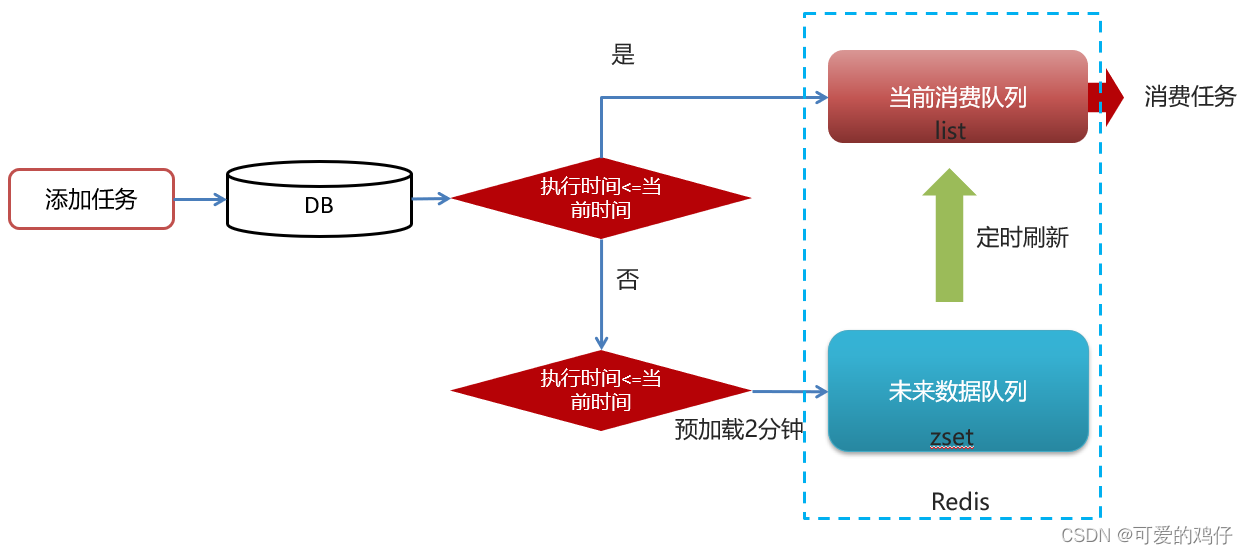
1.问题思路
1.为什么任务需要存储在数据库中?
延迟任务是一个通用的服务,任何需要延迟得任务都可以调用该服务,需要考虑数据持久化的问题,存储数据库中是一种数据安全的考虑。
2.为什么redis中使用两种数据类型,list和zset?
效率问题,算法的时间复杂度
3.在添加zset数据的时候,为什么不需要预加载?
任务模块是一个通用的模块,项目中任何需要延迟队列的地方,都可以调用这个接口,要考虑到数据量的问题,如果数据量特别大,为了防止阻塞,只需要把未来几分钟要执行的数据存入缓存即可。
2.延迟任务服务实现
2.1搭建heima-leadnews-schedule模块
leadnews-schedule是一个通用的服务,单独创建模块来管理任何类型的延迟任务
①:导入资料文件夹下的heima-leadnews-schedule模块到heima-leadnews-service下,如下图所示:
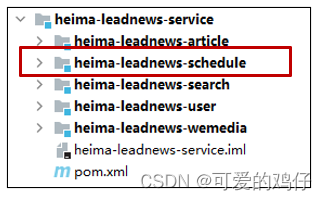
②:添加bootstrap.yml ?
server:
port: 51701
spring:
application:
name: leadnews-schedule
cloud:
nacos:
discovery:
server-addr: 192.168.200.130:8848
config:
server-addr: 192.168.200.130:8848
file-extension: yml③:在nacos中添加对应配置,并添加数据库及mybatis-plus的配置 ?
spring:
datasource:
driver-class-name: com.mysql.jdbc.Driver
url: jdbc:mysql://localhost:3306/leadnews_schedule?useUnicode=true&characterEncoding=UTF-8&serverTimezone=UTC
username: root
password: root
# 设置Mapper接口所对应的XML文件位置,如果你在Mapper接口中有自定义方法,需要进行该配置
mybatis-plus:
mapper-locations: classpath*:mapper/*.xml
# 设置别名包扫描路径,通过该属性可以给包中的类注册别名
type-aliases-package: com.heima.model.schedule.pojos2.2数据库准备
导入资料中leadnews_schedule数据库
taskinfo任务信息表
create database leadnews_schedule;
use leadnews_schedule;
SET FOREIGN_KEY_CHECKS=0;
-- ----------------------------
-- Table structure for taskinfo
-- ----------------------------
DROP TABLE IF EXISTS `taskinfo`;
CREATE TABLE `taskinfo` (
`task_id` bigint(20) NOT NULL COMMENT '任务id',
`execute_time` datetime(3) NOT NULL COMMENT '执行时间',
`parameters` longblob COMMENT '参数',
`priority` int(11) NOT NULL COMMENT '优先级',
`task_type` int(11) NOT NULL COMMENT '任务类型',
PRIMARY KEY (`task_id`),
KEY `index_taskinfo_time` (`task_type`,`priority`,`execute_time`)
) ENGINE=InnoDB DEFAULT CHARSET=utf8;
-- ----------------------------
-- Records of taskinfo
-- ----------------------------
-- ----------------------------
-- Table structure for taskinfo_logs
-- ----------------------------
DROP TABLE IF EXISTS `taskinfo_logs`;
CREATE TABLE `taskinfo_logs` (
`task_id` bigint(20) NOT NULL COMMENT '任务id',
`execute_time` datetime(3) NOT NULL COMMENT '执行时间',
`parameters` longblob COMMENT '参数',
`priority` int(11) NOT NULL COMMENT '优先级',
`task_type` int(11) NOT NULL COMMENT '任务类型',
`version` int(11) NOT NULL COMMENT '版本号,用乐观锁',
`status` int(11) DEFAULT '0' COMMENT '状态 0=初始化状态 1=EXECUTED 2=CANCELLED',
PRIMARY KEY (`task_id`)
) ENGINE=InnoDB DEFAULT CHARSET=utf8;
-- ----------------------------
-- Records of taskinfo_logs
-- ----------------------------
实体类 ?
package com.heima.model.schedule.pojos;
import com.baomidou.mybatisplus.annotation.IdType;
import com.baomidou.mybatisplus.annotation.TableField;
import com.baomidou.mybatisplus.annotation.TableId;
import com.baomidou.mybatisplus.annotation.TableName;
import lombok.Data;
import java.io.Serializable;
import java.util.Date;
/**
* <p>
*
* </p>
*
* @author itheima
*/
@Data
@TableName("taskinfo")
public class Taskinfo implements Serializable {
private static final long serialVersionUID = 1L;
/**
* 任务id
*/
@TableId(type = IdType.ID_WORKER)
private Long taskId;
/**
* 执行时间
*/
@TableField("execute_time")
private Date executeTime;
/**
* 参数
*/
@TableField("parameters")
private byte[] parameters;
/**
* 优先级
*/
@TableField("priority")
private Integer priority;
/**
* 任务类型
*/
@TableField("task_type")
private Integer taskType;
}taskinfo_logs 任务日志表 ?
实体类
package com.heima.model.schedule.pojos;
import com.baomidou.mybatisplus.annotation.*;
import lombok.Data;
import java.io.Serializable;
import java.util.Date;
/**
* <p>
*
* </p>
*
* @author itheima
*/
@Data
@TableName("taskinfo_logs")
public class TaskinfoLogs implements Serializable {
private static final long serialVersionUID = 1L;
/**
* 任务id
*/
@TableId(type = IdType.ID_WORKER)
private Long taskId;
/**
* 执行时间
*/
@TableField("execute_time")
private Date executeTime;
/**
* 参数
*/
@TableField("parameters")
private byte[] parameters;
/**
* 优先级
*/
@TableField("priority")
private Integer priority;
/**
* 任务类型
*/
@TableField("task_type")
private Integer taskType;
/**
* 版本号,用乐观锁
*/
@Version
private Integer version;
/**
* 状态 0=int 1=EXECUTED 2=CANCELLED
*/
@TableField("status")
private Integer status;
}2.3乐观锁
/**
* mybatis-plus乐观锁支持
* @return
*/
@Bean
public MybatisPlusInterceptor optimisticLockerInterceptor(){
MybatisPlusInterceptor interceptor = new MybatisPlusInterceptor();
interceptor.addInnerInterceptor(new OptimisticLockerInnerInterceptor());
return interceptor;
}2.4redis安装
2.4.1引入依赖
<dependency>
<groupId>org.springframework.boot</groupId>
<artifactId>spring-boot-starter-data-redis</artifactId>
</dependency>
<!-- redis依赖commons-pool 这个依赖一定要添加 -->
<dependency>
<groupId>org.apache.commons</groupId>
<artifactId>commons-pool2</artifactId>
</dependency>?2.4.2在heima-leadnews-schedule中集成redis,添加以下nacos配置,链接上redis
spring:
redis:
host: 192.168.200.130
password: leadnews
port: 6379?③ 拷贝资料文件夹下的类:CacheService到heima-leadnews-common模块下,并添加自动配置
2.4.5创建CacheService工具类
package com.heima.common.redis;
import org.springframework.beans.factory.annotation.Autowired;
import org.springframework.cache.annotation.CachingConfigurerSupport;
import org.springframework.dao.DataAccessException;
import org.springframework.data.redis.connection.DataType;
import org.springframework.data.redis.connection.RedisConnection;
import org.springframework.data.redis.connection.StringRedisConnection;
import org.springframework.data.redis.core.Cursor;
import org.springframework.data.redis.core.RedisCallback;
import org.springframework.data.redis.core.ScanOptions;
import org.springframework.data.redis.core.StringRedisTemplate;
import org.springframework.data.redis.core.ZSetOperations.TypedTuple;
import org.springframework.lang.Nullable;
import org.springframework.stereotype.Component;
import java.io.IOException;
import java.util.*;
import java.util.concurrent.TimeUnit;
@Component
public class CacheService extends CachingConfigurerSupport {
@Autowired
private StringRedisTemplate stringRedisTemplate;
public StringRedisTemplate getstringRedisTemplate() {
return this.stringRedisTemplate;
}
/** -------------------key相关操作--------------------- */
/**
* 删除key
*
* @param key
*/
public void delete(String key) {
stringRedisTemplate.delete(key);
}
/**
* 批量删除key
*
* @param keys
*/
public void delete(Collection<String> keys) {
stringRedisTemplate.delete(keys);
}
/**
* 序列化key
*
* @param key
* @return
*/
public byte[] dump(String key) {
return stringRedisTemplate.dump(key);
}
/**
* 是否存在key
*
* @param key
* @return
*/
public Boolean exists(String key) {
return stringRedisTemplate.hasKey(key);
}
/**
* 设置过期时间
*
* @param key
* @param timeout
* @param unit
* @return
*/
public Boolean expire(String key, long timeout, TimeUnit unit) {
return stringRedisTemplate.expire(key, timeout, unit);
}
/**
* 设置过期时间
*
* @param key
* @param date
* @return
*/
public Boolean expireAt(String key, Date date) {
return stringRedisTemplate.expireAt(key, date);
}
/**
* 查找匹配的key
*
* @param pattern
* @return
*/
public Set<String> keys(String pattern) {
return stringRedisTemplate.keys(pattern);
}
/**
* 将当前数据库的 key 移动到给定的数据库 db 当中
*
* @param key
* @param dbIndex
* @return
*/
public Boolean move(String key, int dbIndex) {
return stringRedisTemplate.move(key, dbIndex);
}
/**
* 移除 key 的过期时间,key 将持久保持
*
* @param key
* @return
*/
public Boolean persist(String key) {
return stringRedisTemplate.persist(key);
}
/**
* 返回 key 的剩余的过期时间
*
* @param key
* @param unit
* @return
*/
public Long getExpire(String key, TimeUnit unit) {
return stringRedisTemplate.getExpire(key, unit);
}
/**
* 返回 key 的剩余的过期时间
*
* @param key
* @return
*/
public Long getExpire(String key) {
return stringRedisTemplate.getExpire(key);
}
/**
* 从当前数据库中随机返回一个 key
*
* @return
*/
public String randomKey() {
return stringRedisTemplate.randomKey();
}
/**
* 修改 key 的名称
*
* @param oldKey
* @param newKey
*/
public void rename(String oldKey, String newKey) {
stringRedisTemplate.rename(oldKey, newKey);
}
/**
* 仅当 newkey 不存在时,将 oldKey 改名为 newkey
*
* @param oldKey
* @param newKey
* @return
*/
public Boolean renameIfAbsent(String oldKey, String newKey) {
return stringRedisTemplate.renameIfAbsent(oldKey, newKey);
}
/**
* 返回 key 所储存的值的类型
*
* @param key
* @return
*/
public DataType type(String key) {
return stringRedisTemplate.type(key);
}
/** -------------------string相关操作--------------------- */
/**
* 设置指定 key 的值
* @param key
* @param value
*/
public void set(String key, String value) {
stringRedisTemplate.opsForValue().set(key, value);
}
/**
* 获取指定 key 的值
* @param key
* @return
*/
public String get(String key) {
return stringRedisTemplate.opsForValue().get(key);
}
/**
* 返回 key 中字符串值的子字符
* @param key
* @param start
* @param end
* @return
*/
public String getRange(String key, long start, long end) {
return stringRedisTemplate.opsForValue().get(key, start, end);
}
/**
* 将给定 key 的值设为 value ,并返回 key 的旧值(old value)
*
* @param key
* @param value
* @return
*/
public String getAndSet(String key, String value) {
return stringRedisTemplate.opsForValue().getAndSet(key, value);
}
/**
* 对 key 所储存的字符串值,获取指定偏移量上的位(bit)
*
* @param key
* @param offset
* @return
*/
public Boolean getBit(String key, long offset) {
return stringRedisTemplate.opsForValue().getBit(key, offset);
}
/**
* 批量获取
*
* @param keys
* @return
*/
public List<String> multiGet(Collection<String> keys) {
return stringRedisTemplate.opsForValue().multiGet(keys);
}
/**
* 设置ASCII码, 字符串'a'的ASCII码是97, 转为二进制是'01100001', 此方法是将二进制第offset位值变为value
*
* @param key
* @param
* @param value
* 值,true为1, false为0
* @return
*/
public boolean setBit(String key, long offset, boolean value) {
return stringRedisTemplate.opsForValue().setBit(key, offset, value);
}
/**
* 将值 value 关联到 key ,并将 key 的过期时间设为 timeout
*
* @param key
* @param value
* @param timeout
* 过期时间
* @param unit
* 时间单位, 天:TimeUnit.DAYS 小时:TimeUnit.HOURS 分钟:TimeUnit.MINUTES
* 秒:TimeUnit.SECONDS 毫秒:TimeUnit.MILLISECONDS
*/
public void setEx(String key, String value, long timeout, TimeUnit unit) {
stringRedisTemplate.opsForValue().set(key, value, timeout, unit);
}
/**
* 只有在 key 不存在时设置 key 的值
*
* @param key
* @param value
* @return 之前已经存在返回false,不存在返回true
*/
public boolean setIfAbsent(String key, String value) {
return stringRedisTemplate.opsForValue().setIfAbsent(key, value);
}
/**
* 用 value 参数覆写给定 key 所储存的字符串值,从偏移量 offset 开始
*
* @param key
* @param value
* @param offset
* 从指定位置开始覆写
*/
public void setRange(String key, String value, long offset) {
stringRedisTemplate.opsForValue().set(key, value, offset);
}
/**
* 获取字符串的长度
*
* @param key
* @return
*/
public Long size(String key) {
return stringRedisTemplate.opsForValue().size(key);
}
/**
* 批量添加
*
* @param maps
*/
public void multiSet(Map<String, String> maps) {
stringRedisTemplate.opsForValue().multiSet(maps);
}
/**
* 同时设置一个或多个 key-value 对,当且仅当所有给定 key 都不存在
*
* @param maps
* @return 之前已经存在返回false,不存在返回true
*/
public boolean multiSetIfAbsent(Map<String, String> maps) {
return stringRedisTemplate.opsForValue().multiSetIfAbsent(maps);
}
/**
* 增加(自增长), 负数则为自减
*
* @param key
* @param
* @return
*/
public Long incrBy(String key, long increment) {
return stringRedisTemplate.opsForValue().increment(key, increment);
}
/**
*
* @param key
* @param
* @return
*/
public Double incrByFloat(String key, double increment) {
return stringRedisTemplate.opsForValue().increment(key, increment);
}
/**
* 追加到末尾
*
* @param key
* @param value
* @return
*/
public Integer append(String key, String value) {
return stringRedisTemplate.opsForValue().append(key, value);
}
/** -------------------hash相关操作------------------------- */
/**
* 获取存储在哈希表中指定字段的值
*
* @param key
* @param field
* @return
*/
public Object hGet(String key, String field) {
return stringRedisTemplate.opsForHash().get(key, field);
}
/**
* 获取所有给定字段的值
*
* @param key
* @return
*/
public Map<Object, Object> hGetAll(String key) {
return stringRedisTemplate.opsForHash().entries(key);
}
/**
* 获取所有给定字段的值
*
* @param key
* @param fields
* @return
*/
public List<Object> hMultiGet(String key, Collection<Object> fields) {
return stringRedisTemplate.opsForHash().multiGet(key, fields);
}
public void hPut(String key, String hashKey, String value) {
stringRedisTemplate.opsForHash().put(key, hashKey, value);
}
public void hPutAll(String key, Map<String, String> maps) {
stringRedisTemplate.opsForHash().putAll(key, maps);
}
/**
* 仅当hashKey不存在时才设置
*
* @param key
* @param hashKey
* @param value
* @return
*/
public Boolean hPutIfAbsent(String key, String hashKey, String value) {
return stringRedisTemplate.opsForHash().putIfAbsent(key, hashKey, value);
}
/**
* 删除一个或多个哈希表字段
*
* @param key
* @param fields
* @return
*/
public Long hDelete(String key, Object... fields) {
return stringRedisTemplate.opsForHash().delete(key, fields);
}
/**
* 查看哈希表 key 中,指定的字段是否存在
*
* @param key
* @param field
* @return
*/
public boolean hExists(String key, String field) {
return stringRedisTemplate.opsForHash().hasKey(key, field);
}
/**
* 为哈希表 key 中的指定字段的整数值加上增量 increment
*
* @param key
* @param field
* @param increment
* @return
*/
public Long hIncrBy(String key, Object field, long increment) {
return stringRedisTemplate.opsForHash().increment(key, field, increment);
}
/**
* 为哈希表 key 中的指定字段的整数值加上增量 increment
*
* @param key
* @param field
* @param delta
* @return
*/
public Double hIncrByFloat(String key, Object field, double delta) {
return stringRedisTemplate.opsForHash().increment(key, field, delta);
}
/**
* 获取所有哈希表中的字段
*
* @param key
* @return
*/
public Set<Object> hKeys(String key) {
return stringRedisTemplate.opsForHash().keys(key);
}
/**
* 获取哈希表中字段的数量
*
* @param key
* @return
*/
public Long hSize(String key) {
return stringRedisTemplate.opsForHash().size(key);
}
/**
* 获取哈希表中所有值
*
* @param key
* @return
*/
public List<Object> hValues(String key) {
return stringRedisTemplate.opsForHash().values(key);
}
/**
* 迭代哈希表中的键值对
*
* @param key
* @param options
* @return
*/
public Cursor<Map.Entry<Object, Object>> hScan(String key, ScanOptions options) {
return stringRedisTemplate.opsForHash().scan(key, options);
}
/** ------------------------list相关操作---------------------------- */
/**
* 通过索引获取列表中的元素
*
* @param key
* @param index
* @return
*/
public String lIndex(String key, long index) {
return stringRedisTemplate.opsForList().index(key, index);
}
/**
* 获取列表指定范围内的元素
*
* @param key
* @param start
* 开始位置, 0是开始位置
* @param end
* 结束位置, -1返回所有
* @return
*/
public List<String> lRange(String key, long start, long end) {
return stringRedisTemplate.opsForList().range(key, start, end);
}
/**
* 存储在list头部
*
* @param key
* @param value
* @return
*/
public Long lLeftPush(String key, String value) {
return stringRedisTemplate.opsForList().leftPush(key, value);
}
/**
*
* @param key
* @param value
* @return
*/
public Long lLeftPushAll(String key, String... value) {
return stringRedisTemplate.opsForList().leftPushAll(key, value);
}
/**
*
* @param key
* @param value
* @return
*/
public Long lLeftPushAll(String key, Collection<String> value) {
return stringRedisTemplate.opsForList().leftPushAll(key, value);
}
/**
* 当list存在的时候才加入
*
* @param key
* @param value
* @return
*/
public Long lLeftPushIfPresent(String key, String value) {
return stringRedisTemplate.opsForList().leftPushIfPresent(key, value);
}
/**
* 如果pivot存在,再pivot前面添加
*
* @param key
* @param pivot
* @param value
* @return
*/
public Long lLeftPush(String key, String pivot, String value) {
return stringRedisTemplate.opsForList().leftPush(key, pivot, value);
}
/**
*
* @param key
* @param value
* @return
*/
public Long lRightPush(String key, String value) {
return stringRedisTemplate.opsForList().rightPush(key, value);
}
/**
*
* @param key
* @param value
* @return
*/
public Long lRightPushAll(String key, String... value) {
return stringRedisTemplate.opsForList().rightPushAll(key, value);
}
/**
*
* @param key
* @param value
* @return
*/
public Long lRightPushAll(String key, Collection<String> value) {
return stringRedisTemplate.opsForList().rightPushAll(key, value);
}
/**
* 为已存在的列表添加值
*
* @param key
* @param value
* @return
*/
public Long lRightPushIfPresent(String key, String value) {
return stringRedisTemplate.opsForList().rightPushIfPresent(key, value);
}
/**
* 在pivot元素的右边添加值
*
* @param key
* @param pivot
* @param value
* @return
*/
public Long lRightPush(String key, String pivot, String value) {
return stringRedisTemplate.opsForList().rightPush(key, pivot, value);
}
/**
* 通过索引设置列表元素的值
*
* @param key
* @param index
* 位置
* @param value
*/
public void lSet(String key, long index, String value) {
stringRedisTemplate.opsForList().set(key, index, value);
}
/**
* 移出并获取列表的第一个元素
*
* @param key
* @return 删除的元素
*/
public String lLeftPop(String key) {
return stringRedisTemplate.opsForList().leftPop(key);
}
/**
* 移出并获取列表的第一个元素, 如果列表没有元素会阻塞列表直到等待超时或发现可弹出元素为止
*
* @param key
* @param timeout
* 等待时间
* @param unit
* 时间单位
* @return
*/
public String lBLeftPop(String key, long timeout, TimeUnit unit) {
return stringRedisTemplate.opsForList().leftPop(key, timeout, unit);
}
/**
* 移除并获取列表最后一个元素
*
* @param key
* @return 删除的元素
*/
public String lRightPop(String key) {
return stringRedisTemplate.opsForList().rightPop(key);
}
/**
* 移出并获取列表的最后一个元素, 如果列表没有元素会阻塞列表直到等待超时或发现可弹出元素为止
*
* @param key
* @param timeout
* 等待时间
* @param unit
* 时间单位
* @return
*/
public String lBRightPop(String key, long timeout, TimeUnit unit) {
return stringRedisTemplate.opsForList().rightPop(key, timeout, unit);
}
/**
* 移除列表的最后一个元素,并将该元素添加到另一个列表并返回
*
* @param sourceKey
* @param destinationKey
* @return
*/
public String lRightPopAndLeftPush(String sourceKey, String destinationKey) {
return stringRedisTemplate.opsForList().rightPopAndLeftPush(sourceKey,
destinationKey);
}
/**
* 从列表中弹出一个值,将弹出的元素插入到另外一个列表中并返回它; 如果列表没有元素会阻塞列表直到等待超时或发现可弹出元素为止
*
* @param sourceKey
* @param destinationKey
* @param timeout
* @param unit
* @return
*/
public String lBRightPopAndLeftPush(String sourceKey, String destinationKey,
long timeout, TimeUnit unit) {
return stringRedisTemplate.opsForList().rightPopAndLeftPush(sourceKey,
destinationKey, timeout, unit);
}
/**
* 删除集合中值等于value得元素
*
* @param key
* @param index
* index=0, 删除所有值等于value的元素; index>0, 从头部开始删除第一个值等于value的元素;
* index<0, 从尾部开始删除第一个值等于value的元素;
* @param value
* @return
*/
public Long lRemove(String key, long index, String value) {
return stringRedisTemplate.opsForList().remove(key, index, value);
}
/**
* 裁剪list
*
* @param key
* @param start
* @param end
*/
public void lTrim(String key, long start, long end) {
stringRedisTemplate.opsForList().trim(key, start, end);
}
/**
* 获取列表长度
*
* @param key
* @return
*/
public Long lLen(String key) {
return stringRedisTemplate.opsForList().size(key);
}
/** --------------------set相关操作-------------------------- */
/**
* set添加元素
*
* @param key
* @param values
* @return
*/
public Long sAdd(String key, String... values) {
return stringRedisTemplate.opsForSet().add(key, values);
}
/**
* set移除元素
*
* @param key
* @param values
* @return
*/
public Long sRemove(String key, Object... values) {
return stringRedisTemplate.opsForSet().remove(key, values);
}
/**
* 移除并返回集合的一个随机元素
*
* @param key
* @return
*/
public String sPop(String key) {
return stringRedisTemplate.opsForSet().pop(key);
}
/**
* 将元素value从一个集合移到另一个集合
*
* @param key
* @param value
* @param destKey
* @return
*/
public Boolean sMove(String key, String value, String destKey) {
return stringRedisTemplate.opsForSet().move(key, value, destKey);
}
/**
* 获取集合的大小
*
* @param key
* @return
*/
public Long sSize(String key) {
return stringRedisTemplate.opsForSet().size(key);
}
/**
* 判断集合是否包含value
*
* @param key
* @param value
* @return
*/
public Boolean sIsMember(String key, Object value) {
return stringRedisTemplate.opsForSet().isMember(key, value);
}
/**
* 获取两个集合的交集
*
* @param key
* @param otherKey
* @return
*/
public Set<String> sIntersect(String key, String otherKey) {
return stringRedisTemplate.opsForSet().intersect(key, otherKey);
}
/**
* 获取key集合与多个集合的交集
*
* @param key
* @param otherKeys
* @return
*/
public Set<String> sIntersect(String key, Collection<String> otherKeys) {
return stringRedisTemplate.opsForSet().intersect(key, otherKeys);
}
/**
* key集合与otherKey集合的交集存储到destKey集合中
*
* @param key
* @param otherKey
* @param destKey
* @return
*/
public Long sIntersectAndStore(String key, String otherKey, String destKey) {
return stringRedisTemplate.opsForSet().intersectAndStore(key, otherKey,
destKey);
}
/**
* key集合与多个集合的交集存储到destKey集合中
*
* @param key
* @param otherKeys
* @param destKey
* @return
*/
public Long sIntersectAndStore(String key, Collection<String> otherKeys,
String destKey) {
return stringRedisTemplate.opsForSet().intersectAndStore(key, otherKeys,
destKey);
}
/**
* 获取两个集合的并集
*
* @param key
* @param otherKeys
* @return
*/
public Set<String> sUnion(String key, String otherKeys) {
return stringRedisTemplate.opsForSet().union(key, otherKeys);
}
/**
* 获取key集合与多个集合的并集
*
* @param key
* @param otherKeys
* @return
*/
public Set<String> sUnion(String key, Collection<String> otherKeys) {
return stringRedisTemplate.opsForSet().union(key, otherKeys);
}
/**
* key集合与otherKey集合的并集存储到destKey中
*
* @param key
* @param otherKey
* @param destKey
* @return
*/
public Long sUnionAndStore(String key, String otherKey, String destKey) {
return stringRedisTemplate.opsForSet().unionAndStore(key, otherKey, destKey);
}
/**
* key集合与多个集合的并集存储到destKey中
*
* @param key
* @param otherKeys
* @param destKey
* @return
*/
public Long sUnionAndStore(String key, Collection<String> otherKeys,
String destKey) {
return stringRedisTemplate.opsForSet().unionAndStore(key, otherKeys, destKey);
}
/**
* 获取两个集合的差集
*
* @param key
* @param otherKey
* @return
*/
public Set<String> sDifference(String key, String otherKey) {
return stringRedisTemplate.opsForSet().difference(key, otherKey);
}
/**
* 获取key集合与多个集合的差集
*
* @param key
* @param otherKeys
* @return
*/
public Set<String> sDifference(String key, Collection<String> otherKeys) {
return stringRedisTemplate.opsForSet().difference(key, otherKeys);
}
/**
* key集合与otherKey集合的差集存储到destKey中
*
* @param key
* @param otherKey
* @param destKey
* @return
*/
public Long sDifference(String key, String otherKey, String destKey) {
return stringRedisTemplate.opsForSet().differenceAndStore(key, otherKey,
destKey);
}
/**
* key集合与多个集合的差集存储到destKey中
*
* @param key
* @param otherKeys
* @param destKey
* @return
*/
public Long sDifference(String key, Collection<String> otherKeys,
String destKey) {
return stringRedisTemplate.opsForSet().differenceAndStore(key, otherKeys,
destKey);
}
/**
* 获取集合所有元素
*
* @param key
* @param
* @param
* @return
*/
public Set<String> setMembers(String key) {
return stringRedisTemplate.opsForSet().members(key);
}
/**
* 随机获取集合中的一个元素
*
* @param key
* @return
*/
public String sRandomMember(String key) {
return stringRedisTemplate.opsForSet().randomMember(key);
}
/**
* 随机获取集合中count个元素
*
* @param key
* @param count
* @return
*/
public List<String> sRandomMembers(String key, long count) {
return stringRedisTemplate.opsForSet().randomMembers(key, count);
}
/**
* 随机获取集合中count个元素并且去除重复的
*
* @param key
* @param count
* @return
*/
public Set<String> sDistinctRandomMembers(String key, long count) {
return stringRedisTemplate.opsForSet().distinctRandomMembers(key, count);
}
/**
*
* @param key
* @param options
* @return
*/
public Cursor<String> sScan(String key, ScanOptions options) {
return stringRedisTemplate.opsForSet().scan(key, options);
}
/**------------------zSet相关操作--------------------------------*/
/**
* 添加元素,有序集合是按照元素的score值由小到大排列
*
* @param key
* @param value
* @param score
* @return
*/
public Boolean zAdd(String key, String value, double score) {
return stringRedisTemplate.opsForZSet().add(key, value, score);
}
/**
*
* @param key
* @param values
* @return
*/
public Long zAdd(String key, Set<TypedTuple<String>> values) {
return stringRedisTemplate.opsForZSet().add(key, values);
}
/**
*
* @param key
* @param values
* @return
*/
public Long zRemove(String key, Object... values) {
return stringRedisTemplate.opsForZSet().remove(key, values);
}
public Long zRemove(String key, Collection<String> values) {
if(values!=null&&!values.isEmpty()){
Object[] objs = values.toArray(new Object[values.size()]);
return stringRedisTemplate.opsForZSet().remove(key, objs);
}
return 0L;
}
/**
* 增加元素的score值,并返回增加后的值
*
* @param key
* @param value
* @param delta
* @return
*/
public Double zIncrementScore(String key, String value, double delta) {
return stringRedisTemplate.opsForZSet().incrementScore(key, value, delta);
}
/**
* 返回元素在集合的排名,有序集合是按照元素的score值由小到大排列
*
* @param key
* @param value
* @return 0表示第一位
*/
public Long zRank(String key, Object value) {
return stringRedisTemplate.opsForZSet().rank(key, value);
}
/**
* 返回元素在集合的排名,按元素的score值由大到小排列
*
* @param key
* @param value
* @return
*/
public Long zReverseRank(String key, Object value) {
return stringRedisTemplate.opsForZSet().reverseRank(key, value);
}
/**
* 获取集合的元素, 从小到大排序
*
* @param key
* @param start
* 开始位置
* @param end
* 结束位置, -1查询所有
* @return
*/
public Set<String> zRange(String key, long start, long end) {
return stringRedisTemplate.opsForZSet().range(key, start, end);
}
/**
* 获取zset集合的所有元素, 从小到大排序
*
*/
public Set<String> zRangeAll(String key) {
return zRange(key,0,-1);
}
/**
* 获取集合元素, 并且把score值也获取
*
* @param key
* @param start
* @param end
* @return
*/
public Set<TypedTuple<String>> zRangeWithScores(String key, long start,
long end) {
return stringRedisTemplate.opsForZSet().rangeWithScores(key, start, end);
}
/**
* 根据Score值查询集合元素
*
* @param key
* @param min
* 最小值
* @param max
* 最大值
* @return
*/
public Set<String> zRangeByScore(String key, double min, double max) {
return stringRedisTemplate.opsForZSet().rangeByScore(key, min, max);
}
/**
* 根据Score值查询集合元素, 从小到大排序
*
* @param key
* @param min
* 最小值
* @param max
* 最大值
* @return
*/
public Set<TypedTuple<String>> zRangeByScoreWithScores(String key,
double min, double max) {
return stringRedisTemplate.opsForZSet().rangeByScoreWithScores(key, min, max);
}
/**
*
* @param key
* @param min
* @param max
* @param start
* @param end
* @return
*/
public Set<TypedTuple<String>> zRangeByScoreWithScores(String key,
double min, double max, long start, long end) {
return stringRedisTemplate.opsForZSet().rangeByScoreWithScores(key, min, max,
start, end);
}
/**
* 获取集合的元素, 从大到小排序
*
* @param key
* @param start
* @param end
* @return
*/
public Set<String> zReverseRange(String key, long start, long end) {
return stringRedisTemplate.opsForZSet().reverseRange(key, start, end);
}
public Set<String> zReverseRangeByScore(String key, long min, long max) {
return stringRedisTemplate.opsForZSet().reverseRangeByScore(key, min, max);
}
/**
* 获取集合的元素, 从大到小排序, 并返回score值
*
* @param key
* @param start
* @param end
* @return
*/
public Set<TypedTuple<String>> zReverseRangeWithScores(String key,
long start, long end) {
return stringRedisTemplate.opsForZSet().reverseRangeWithScores(key, start,
end);
}
/**
* 根据Score值查询集合元素, 从大到小排序
*
* @param key
* @param min
* @param max
* @return
*/
public Set<String> zReverseRangeByScore(String key, double min,
double max) {
return stringRedisTemplate.opsForZSet().reverseRangeByScore(key, min, max);
}
/**
* 根据Score值查询集合元素, 从大到小排序
*
* @param key
* @param min
* @param max
* @return
*/
public Set<TypedTuple<String>> zReverseRangeByScoreWithScores(
String key, double min, double max) {
return stringRedisTemplate.opsForZSet().reverseRangeByScoreWithScores(key,
min, max);
}
/**
*
* @param key
* @param min
* @param max
* @param start
* @param end
* @return
*/
public Set<String> zReverseRangeByScore(String key, double min,
double max, long start, long end) {
return stringRedisTemplate.opsForZSet().reverseRangeByScore(key, min, max,
start, end);
}
/**
* 根据score值获取集合元素数量
*
* @param key
* @param min
* @param max
* @return
*/
public Long zCount(String key, double min, double max) {
return stringRedisTemplate.opsForZSet().count(key, min, max);
}
/**
* 获取集合大小
*
* @param key
* @return
*/
public Long zSize(String key) {
return stringRedisTemplate.opsForZSet().size(key);
}
/**
* 获取集合大小
*
* @param key
* @return
*/
public Long zZCard(String key) {
return stringRedisTemplate.opsForZSet().zCard(key);
}
/**
* 获取集合中value元素的score值
*
* @param key
* @param value
* @return
*/
public Double zScore(String key, Object value) {
return stringRedisTemplate.opsForZSet().score(key, value);
}
/**
* 移除指定索引位置的成员
*
* @param key
* @param start
* @param end
* @return
*/
public Long zRemoveRange(String key, long start, long end) {
return stringRedisTemplate.opsForZSet().removeRange(key, start, end);
}
/**
* 根据指定的score值的范围来移除成员
*
* @param key
* @param min
* @param max
* @return
*/
public Long zRemoveRangeByScore(String key, double min, double max) {
return stringRedisTemplate.opsForZSet().removeRangeByScore(key, min, max);
}
/**
* 获取key和otherKey的并集并存储在destKey中
*
* @param key
* @param otherKey
* @param destKey
* @return
*/
public Long zUnionAndStore(String key, String otherKey, String destKey) {
return stringRedisTemplate.opsForZSet().unionAndStore(key, otherKey, destKey);
}
/**
*
* @param key
* @param otherKeys
* @param destKey
* @return
*/
public Long zUnionAndStore(String key, Collection<String> otherKeys,
String destKey) {
return stringRedisTemplate.opsForZSet()
.unionAndStore(key, otherKeys, destKey);
}
/**
* 交集
*
* @param key
* @param otherKey
* @param destKey
* @return
*/
public Long zIntersectAndStore(String key, String otherKey,
String destKey) {
return stringRedisTemplate.opsForZSet().intersectAndStore(key, otherKey,
destKey);
}
/**
* 交集
*
* @param key
* @param otherKeys
* @param destKey
* @return
*/
public Long zIntersectAndStore(String key, Collection<String> otherKeys,
String destKey) {
return stringRedisTemplate.opsForZSet().intersectAndStore(key, otherKeys,
destKey);
}
/**
*
* @param key
* @param options
* @return
*/
public Cursor<TypedTuple<String>> zScan(String key, ScanOptions options) {
return stringRedisTemplate.opsForZSet().scan(key, options);
}
/**
* 扫描主键,建议使用
* @param patten
* @return
*/
public Set<String> scan(String patten){
Set<String> keys = stringRedisTemplate.execute((RedisCallback<Set<String>>) connection -> {
Set<String> result = new HashSet<>();
try (Cursor<byte[]> cursor = connection.scan(new ScanOptions.ScanOptionsBuilder()
.match(patten).count(10000).build())) {
while (cursor.hasNext()) {
result.add(new String(cursor.next()));
}
} catch (IOException e) {
e.printStackTrace();
}
return result;
});
return keys;
}
/**
* 管道技术,提高性能
* @param type
* @param values
* @return
*/
public List<Object> lRightPushPipeline(String type,Collection<String> values){
List<Object> results = stringRedisTemplate.executePipelined(new RedisCallback<Object>() {
public Object doInRedis(RedisConnection connection) throws DataAccessException {
StringRedisConnection stringRedisConn = (StringRedisConnection)connection;
//集合转换数组
String[] strings = values.toArray(new String[values.size()]);
//直接批量发送
stringRedisConn.rPush(type, strings);
return null;
}
});
return results;
}
public List<Object> refreshWithPipeline(String future_key,String topic_key,Collection<String> values){
List<Object> objects = stringRedisTemplate.executePipelined(new RedisCallback<Object>() {
@Nullable
@Override
public Object doInRedis(RedisConnection redisConnection) throws DataAccessException {
StringRedisConnection stringRedisConnection = (StringRedisConnection)redisConnection;
String[] strings = values.toArray(new String[values.size()]);
stringRedisConnection.rPush(topic_key,strings);
stringRedisConnection.zRem(future_key,strings);
return null;
}
});
return objects;
}
}2.4.6测试
package com.heima.schedule.test;
import com.heima.common.redis.CacheService;
import com.heima.schedule.ScheduleApplication;
import org.junit.Test;
import org.junit.runner.RunWith;
import org.springframework.beans.factory.annotation.Autowired;
import org.springframework.boot.test.context.SpringBootTest;
import org.springframework.test.context.junit4.SpringRunner;
import java.util.Set;
@SpringBootTest(classes = ScheduleApplication.class)
@RunWith(SpringRunner.class)
public class RedisTest {
@Autowired
private CacheService cacheService;
@Test
public void testList(){
//在list的左边添加元素
// cacheService.lLeftPush("list_001","hello,redis");
//在list的右边获取元素,并删除
String list_001 = cacheService.lRightPop("list_001");
System.out.println(list_001);
}
@Test
public void testZset(){
//添加数据到zset中 分值
/*cacheService.zAdd("zset_key_001","hello zset 001",1000);
cacheService.zAdd("zset_key_001","hello zset 002",8888);
cacheService.zAdd("zset_key_001","hello zset 003",7777);
cacheService.zAdd("zset_key_001","hello zset 004",999999);*/
//按照分值获取数据
Set<String> zset_key_001 = cacheService.zRangeByScore("zset_key_001", 0, 8888);
System.out.println(zset_key_001);
}
}查看Redis结果
?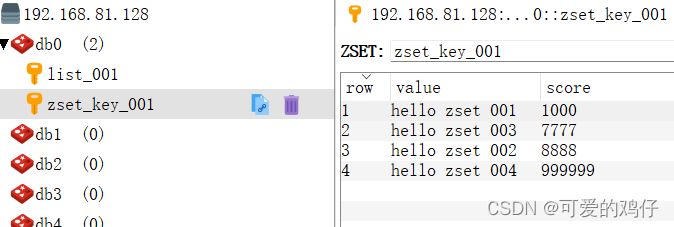
可以看到,这些内容按照分数进行了从小到大的排序,可以满足我们的延迟任务的要求
3.添加任务
3.1创建task类,用于接收添加任务的参数
package com.heima.model.schedule.dtos;
import lombok.Data;
import java.io.Serializable;
@Data
public class Task implements Serializable {
/**
* 任务id
*/
private Long taskId;
/**
* 类型
*/
private Integer taskType;
/**
* 优先级
*/
private Integer priority;
/**
* 执行id
*/
private long executeTime;
/**
* task参数
*/
private byte[] parameters;
}3.2创建TaskService
package com.heima.schedule.service;
import com.heima.model.schedule.dtos.Task;
/**
* 对外访问接口
*/
public interface TaskService {
/**
* 添加任务
* @param task 任务对象
* @return 任务id
*/
public long addTask(Task task) ;
}3.3实现类
package com.heima.schedule.service.impl;
import com.alibaba.fastjson.JSON;
import com.heima.common.constants.ScheduleConstants;
import com.heima.common.redis.CacheService;
import com.heima.model.schedule.dtos.Task;
import com.heima.model.schedule.pojos.Taskinfo;
import com.heima.model.schedule.pojos.TaskinfoLogs;
import com.heima.schedule.mapper.TaskinfoLogsMapper;
import com.heima.schedule.mapper.TaskinfoMapper;
import com.heima.schedule.service.TaskService;
import lombok.extern.slf4j.Slf4j;
import org.springframework.beans.BeanUtils;
import org.springframework.beans.factory.annotation.Autowired;
import org.springframework.stereotype.Service;
import org.springframework.transaction.annotation.Transactional;
import java.util.Calendar;
import java.util.Date;
@Service
@Transactional
@Slf4j
public class TaskServiceImpl implements TaskService {
/**
* 添加延迟任务
*
* @param task
* @return
*/
@Override
public long addTask(Task task) {
//1.添加任务到数据库中
boolean success = addTaskToDb(task);
if (success) {
//2.添加任务到redis
addTaskToCache(task);
}
return task.getTaskId();
}
@Autowired
private CacheService cacheService;
/**
* 把任务添加到redis中
*
* @param task
*/
private void addTaskToCache(Task task) {
String key = task.getTaskType() + "_" + task.getPriority();
//获取5分钟之后的时间 毫秒值
Calendar calendar = Calendar.getInstance();
calendar.add(Calendar.MINUTE, 5);
long nextScheduleTime = calendar.getTimeInMillis();
//2.1 如果任务的执行时间小于等于当前时间,存入list
if (task.getExecuteTime() <= System.currentTimeMillis()) {
cacheService.lLeftPush(ScheduleConstants.TOPIC + key, JSON.toJSONString(task));
} else if (task.getExecuteTime() <= nextScheduleTime) {
//2.2 如果任务的执行时间大于当前时间 && 小于等于预设时间(未来5分钟) 存入zset中
cacheService.zAdd(ScheduleConstants.FUTURE + key, JSON.toJSONString(task), task.getExecuteTime());
}
}
@Autowired
private TaskinfoMapper taskinfoMapper;
@Autowired
private TaskinfoLogsMapper taskinfoLogsMapper;
/**
* 添加任务到数据库中
*
* @param task
* @return
*/
private boolean addTaskToDb(Task task) {
boolean flag = false;
try {
//保存任务表
Taskinfo taskinfo = new Taskinfo();
BeanUtils.copyProperties(task, taskinfo);
taskinfo.setExecuteTime(new Date(task.getExecuteTime()));
taskinfoMapper.insert(taskinfo);
//设置taskID
task.setTaskId(taskinfo.getTaskId());
//保存任务日志数据
TaskinfoLogs taskinfoLogs = new TaskinfoLogs();
BeanUtils.copyProperties(taskinfo, taskinfoLogs);
taskinfoLogs.setVersion(1);
taskinfoLogs.setStatus(ScheduleConstants.SCHEDULED);
taskinfoLogsMapper.insert(taskinfoLogs);
flag = true;
} catch (Exception e) {
e.printStackTrace();
}
return flag;
}
}3.4TaskInfoMapper和TaskInfoLogMapper
@Mapper
public interface TaskinfoMapper extends BaseMapper<Taskinfo> {
public List<Taskinfo> queryFutureTime(@Param("taskType")int type, @Param("priority")int priority, @Param("future")Date future);
}
@Mapper
public interface TaskinfoLogsMapper extends BaseMapper<TaskinfoLogs> {
}3.5ScheduleConstants常量类
package com.heima.common.constants;
public class ScheduleConstants {
//task状态
public static final int SCHEDULED=0; //初始化状态
public static final int EXECUTED=1; //已执行状态
public static final int CANCELLED=2; //已取消状态
public static String FUTURE="future_"; //未来数据key前缀
public static String TOPIC="topic_"; //当前数据key前缀
}?3.6测试
/**
* 延迟任务测试
*/
@SpringBootTest
public class TaskServiceTest {
@Autowired
private TaskService taskService;
@Test
void testTaskNow(){
Task task = new Task();
task.setTaskType(1);
task.setPriority(1);
task.setParameters(new byte[]{12,31,21});
task.setExecuteTime(System.currentTimeMillis());
taskService.addTask(task);
}
@Test
void testTaskFuture(){
//两分钟之后发布
Task task1= new Task();
task1.setTaskType(1);
task1.setPriority(1);
task1.setParameters(new byte[]{12,31,21});
task1.setExecuteTime(System.currentTimeMillis()+1000 * 60 *2);
//三分钟之后发布
Task task2 = new Task();
task2.setTaskType(1);
task2.setPriority(1);
task2.setParameters(new byte[]{81,23,14});
task2.setExecuteTime(System.currentTimeMillis()+1000*60*3);
taskService.addTask(task1);
taskService.addTask(task2);
}
}
1.先测试第一个立即执行

 ?任务表和日志表中插入了立即执行的任务记录,在查看一下Redis:
?任务表和日志表中插入了立即执行的任务记录,在查看一下Redis:

可以看到,加入到了topic的list列表中,立即执行
下面在测试以下未来延迟执行:


可以看到已经插入了两条延迟执行的任务记录,下面看一下redis:

可以看到redis中插入了两条延迟执行的任务记录,使用了future,zset集合
4.取消任务
/**
* 取消任务
* @param taskId 任务id
* @return 取消结果
*/
public boolean cancelTask(long taskId);
/**
* 取消任务
* @param taskId
* @return
*/
@Override
public boolean cancelTask(long taskId) {
boolean flag = false;
//删除任务,更新日志
Task task = updateDb(taskId,ScheduleConstants.EXECUTED);
//删除redis的数据
if(task != null){
removeTaskFromCache(task);
flag = true;
}
return false;
}
/**
* 删除redis中的任务数据
* @param task
*/
private void removeTaskFromCache(Task task) {
String key = task.getTaskType()+"_"+task.getPriority();
if(task.getExecuteTime()<=System.currentTimeMillis()){
cacheService.lRemove(ScheduleConstants.TOPIC+key,0,JSON.toJSONString(task));
}else {
cacheService.zRemove(ScheduleConstants.FUTURE+key, JSON.toJSONString(task));
}
}
/**
* 删除任务,更新任务日志状态
* @param taskId
* @param status
* @return
*/
private Task updateDb(long taskId, int status) {
Task task = null;
try {
//删除任务
taskinfoMapper.deleteById(taskId);
TaskinfoLogs taskinfoLogs = taskinfoLogsMapper.selectById(taskId);
taskinfoLogs.setStatus(status);
taskinfoLogsMapper.updateById(taskinfoLogs);
task = new Task();
BeanUtils.copyProperties(taskinfoLogs,task);
task.setExecuteTime(taskinfoLogs.getExecuteTime().getTime());
}catch (Exception e){
log.error("task cancel exception taskid={}",taskId);
}
return task;
}5.消费任务
/**
* 按照类型和优先级来拉取任务
* @param type
* @param priority
* @return
*/
public Task poll(int type,int priority);/**
* 按照类型和优先级拉取任务
* @return
*/
@Override
public Task poll(int type,int priority) {
Task task = null;
try {
String key = type+"_"+priority;
String task_json = cacheService.lRightPop(ScheduleConstants.TOPIC + key);
if(StringUtils.isNotBlank(task_json)){
task = JSON.parseObject(task_json, Task.class);
//更新数据库信息
updateDb(task.getTaskId(),ScheduleConstants.EXECUTED);
}
}catch (Exception e){
e.printStackTrace();
log.error("poll task exception");
}
return task;
}6.未来数据定时刷新
6.1reids key值匹配
方案1:keys 模糊匹配
keys的模糊匹配功能很方便也很强大,但是在生产环境需要慎用!开发中使用keys的模糊匹配却发现redis的CPU使用率极高,所以公司的redis生产环境将keys命令禁用了!redis是单线程,会被堵塞
?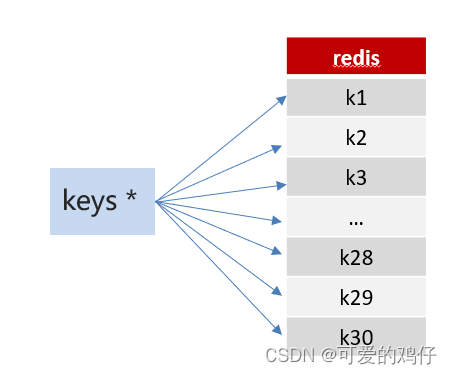
方案2:scan
SCAN 命令是一个基于游标的迭代器,SCAN命令每次被调用之后, 都会向用户返回一个新的游标, 用户在下次迭代时需要使用这个新游标作为SCAN命令的游标参数, 以此来延续之前的迭代过程。
 ?
?
6.2reids管道
普通redis客户端和服务器交互模式
?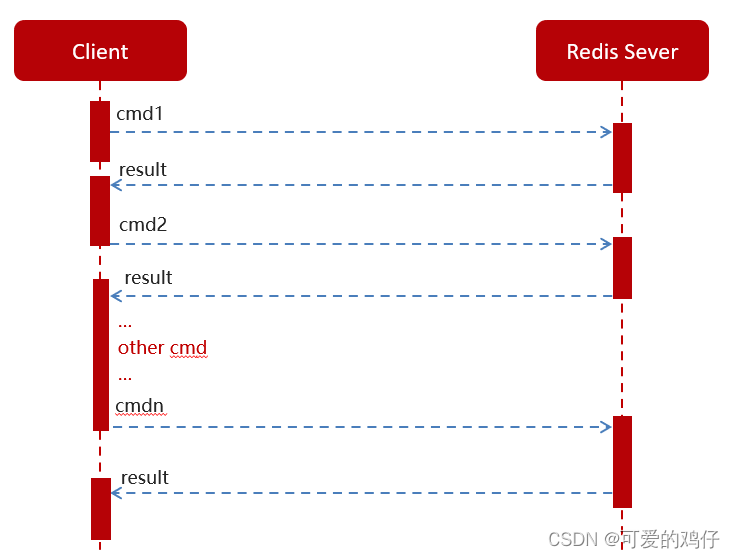
Pipeline请求模型 ?
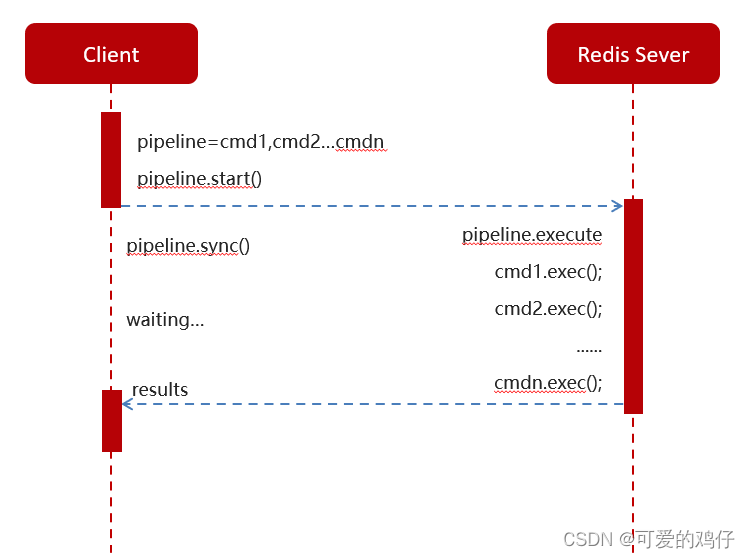 ?
?
官方测试结果
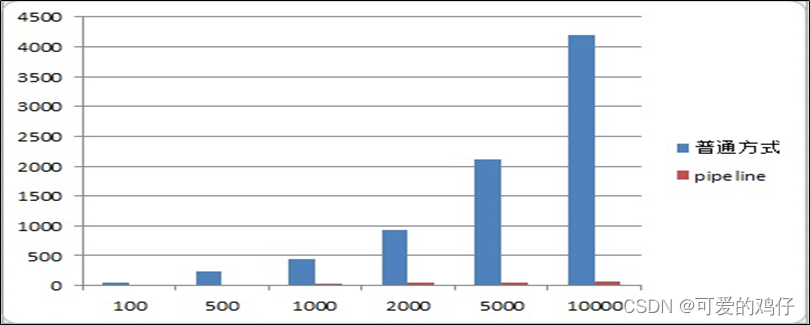 ?
?
6.3测试案例对比: ?
//耗时6151
@Test
public void testPiple1(){
long start =System.currentTimeMillis();
for (int i = 0; i <10000 ; i++) {
Task task = new Task();
task.setTaskType(1001);
task.setPriority(1);
task.setExecuteTime(new Date().getTime());
cacheService.lLeftPush("1001_1", JSON.toJSONString(task));
}
System.out.println("耗时"+(System.currentTimeMillis()- start));
}
@Test
public void testPiple2(){
long start = System.currentTimeMillis();
//使用管道技术
List<Object> objectList = cacheService.getstringRedisTemplate().executePipelined(new RedisCallback<Object>() {
@Nullable
@Override
public Object doInRedis(RedisConnection redisConnection) throws DataAccessException {
for (int i = 0; i <10000 ; i++) {
Task task = new Task();
task.setTaskType(1001);
task.setPriority(1);
task.setExecuteTime(new Date().getTime());
redisConnection.lPush("1001_1".getBytes(), JSON.toJSONString(task).getBytes());
}
return null;
}
});
System.out.println("使用管道技术执行10000次自增操作共耗时:"+(System.currentTimeMillis()-start)+"毫秒");
}?6.4具体实现
在TaskService中添加方法 ?
@Scheduled(cron = "0 */1 * * * ?")
public void refresh() {
System.out.println(System.currentTimeMillis() / 1000 + "执行了定时任务");
// 获取所有未来数据集合的key值
Set<String> futureKeys = cacheService.scan(ScheduleConstants.FUTURE + "*");// future_*
for (String futureKey : futureKeys) { // future_250_250
String topicKey = ScheduleConstants.TOPIC + futureKey.split(ScheduleConstants.FUTURE)[1];
//获取该组key下当前需要消费的任务数据
Set<String> tasks = cacheService.zRangeByScore(futureKey, 0, System.currentTimeMillis());
if (!tasks.isEmpty()) {
//将这些任务数据添加到消费者队列中
cacheService.refreshWithPipeline(futureKey, topicKey, tasks);
System.out.println("成功的将" + futureKey + "下的当前需要执行的任务数据刷新到" + topicKey + "下");
}
}
}?解释一下:
? 它会每隔一分钟执行一次,查询所有的未来future_key*,然后获取里面的延迟任务,去判断时间时候符合,如果符合,就把延迟任务取出,并且删除zset,将他们添加到topic_的list立即任务中
测试运行
?先向数据库中添加三条延迟任务:
@Test
void testTaskFuture(){
//两分钟之后发布
Task task1= new Task();
task1.setTaskType(1);
task1.setPriority(1);
task1.setParameters(new byte[]{12,31,21});
task1.setExecuteTime(System.currentTimeMillis()+1000 * 60 *2);
//三分钟之后发布
Task task2 = new Task();
task2.setTaskType(1);
task2.setPriority(2);
task2.setParameters(new byte[]{81,23,14});
task2.setExecuteTime(System.currentTimeMillis()+1000*60*3);
Task task3 = new Task();
task3.setTaskType(1);
task3.setPriority(3);
task3.setParameters(new byte[]{81,23,14});
task3.setExecuteTime(System.currentTimeMillis()+1000*60*3);
taskService.addTask(task1);
taskService.addTask(task2);
taskService.addTask(task3);
}然后测试执行
查看结果:

?注意:这三条延迟任务是有时间间隔的,第一条延迟一分钟,第二条延迟三分钟,第三条延迟三分钟,所以刚开始测试的时候并没有刷新到topic,等一段时间后就可以刷新了!
?三.分布式锁解决集群下的方法抢占执行
启动两台heima-leadnews-schedule服务,每台服务都会去执行refresh定时任务方法 ?
 ?
?
 ?
?
redis分布式锁
 ?
?
这种加锁的思路是,如果 key 不存在则为 key 设置 value,如果 key 已存在则 SETNX 命令不做任何操作
-
客户端A请求服务器设置key的值,如果设置成功就表示加锁成功
-
客户端B也去请求服务器设置key的值,如果返回失败,那么就代表加锁失败
-
客户端A执行代码完成,删除锁
-
客户端B在等待一段时间后再去请求设置key的值,设置成功
-
客户端B执行代码完成,删除锁
redisson分布式锁
本项目作者采用redission分布式锁,
1.引入依赖
<dependency>
<groupId>org.redisson</groupId>
<artifactId>redisson</artifactId>
<version>3.23.1</version>
</dependency>?2.配置redissionClient
@Configuration
public class RedisConfig {
@Value("${spring.redis.host}")
private String host;
@Value("${spring.redis.port}")
private String port;
@Value("${spring.redis.password}")
private String password;
@Bean
public RedissonClient redissonClient(){
Config config = new Config();
// System.out.println(host+":"+port+"密码:"+password);
config.useSingleServer().setAddress("redis://"+host+":"+port).setPassword(password).setDatabase(0);
return Redisson.create(config);
}
}
3.加锁
@Resource
private RedissonClient redissonClient;
@Scheduled(cron = "0 */1 * * * ?")
public void refresh() {
System.out.println(System.currentTimeMillis() / 1000 + "执行了定时任务");
//加锁
//先生成一个key
String key = "FUTURE_LOCK";
RLock lock = redissonClient.getLock(key);
try {
//加锁 ,过期时间为1分钟
lock.lock(1, TimeUnit.MINUTES);
// 获取所有未来数据集合的key值
Set<String> futureKeys = cacheService.scan(ScheduleConstants.FUTURE + "*");// future_*
for (String futureKey : futureKeys) { // future_250_250
String topicKey = ScheduleConstants.TOPIC + futureKey.substring(futureKey.indexOf("_"));
//获取该组key下当前需要消费的任务数据
Set<String> tasks = cacheService.zRangeByScore(futureKey, 0, System.currentTimeMillis());
if (!tasks.isEmpty()) {
//将这些任务数据添加到消费者队列中
cacheService.refreshWithPipeline(futureKey, topicKey, tasks);
System.out.println("成功的将" + futureKey + "下的当前需要执行的任务数据刷新到" + topicKey + "下");
}
}
}catch (Exception e){
log.error("定时任务执行异常:"+e.getMessage());
throw new RuntimeException("定时任务执行异常"+e.getMessage());
}finally {
//最终一定要释放锁
lock.unlock();
}
四.数据库同步到redis
 ?
?
@Scheduled(cron = "0 */5 * * * ?")
@PostConstruct
public void reloadData() {
clearCache();
log.info("数据库数据同步到缓存");
Calendar calendar = Calendar.getInstance();
calendar.add(Calendar.MINUTE, 5);
//查看小于未来5分钟的所有任务
List<Taskinfo> allTasks = taskinfoMapper.selectList(Wrappers.<Taskinfo>lambdaQuery().lt(Taskinfo::getExecuteTime,calendar.getTime()));
if(allTasks != null && allTasks.size() > 0){
for (Taskinfo taskinfo : allTasks) {
Task task = new Task();
BeanUtils.copyProperties(taskinfo,task);
task.setExecuteTime(taskinfo.getExecuteTime().getTime());
addTaskToCache(task);
}
}
}
private void clearCache(){
// 删除缓存中未来数据集合和当前消费者队列的所有key
Set<String> futurekeys = cacheService.scan(ScheduleConstants.FUTURE + "*");// future_
Set<String> topickeys = cacheService.scan(ScheduleConstants.TOPIC + "*");// topic_
cacheService.delete(futurekeys);
cacheService.delete(topickeys);
}五.延迟队列解决精准时间发布文章
1.提供远程的feign接口,在heima-leadnews-feign-api编写类如下: ?
package com.heima.apis.schedule;
import com.heima.model.common.dtos.ResponseResult;
import com.heima.model.schedule.dtos.Task;
import org.springframework.cloud.openfeign.FeignClient;
import org.springframework.web.bind.annotation.GetMapping;
import org.springframework.web.bind.annotation.PathVariable;
import org.springframework.web.bind.annotation.PostMapping;
import org.springframework.web.bind.annotation.RequestBody;
@FeignClient("leadnews-schedule")
public interface IScheduleClient {
/**
* 添加任务
* @param task 任务对象
* @return 任务id
*/
@PostMapping("/api/v1/task/add")
public ResponseResult addTask(@RequestBody Task task);
/**
* 取消任务
* @param taskId 任务id
* @return 取消结果
*/
@GetMapping("/api/v1/task/cancel/{taskId}")
public ResponseResult cancelTask(@PathVariable("taskId") long taskId);
/**
* 按照类型和优先级来拉取任务
* @param type
* @param priority
* @return
*/
@GetMapping("/api/v1/task/poll/{type}/{priority}")
public ResponseResult poll(@PathVariable("type") int type,@PathVariable("priority") int priority);
}2.在heima-leadnews-schedule微服务下提供对应的实现 ?
package com.heima.schedule.feign;
import com.heima.apis.schedule.IScheduleClient;
import com.heima.model.common.dtos.ResponseResult;
import com.heima.model.schedule.dtos.Task;
import com.heima.schedule.service.TaskService;
import org.springframework.beans.factory.annotation.Autowired;
import org.springframework.web.bind.annotation.*;
@RestController
public class ScheduleClient implements IScheduleClient {
@Autowired
private TaskService taskService;
/**
* 添加任务
* @param task 任务对象
* @return 任务id
*/
@PostMapping("/api/v1/task/add")
@Override
public ResponseResult addTask(@RequestBody Task task) {
return ResponseResult.okResult(taskService.addTask(task));
}
/**
* 取消任务
* @param taskId 任务id
* @return 取消结果
*/
@GetMapping("/api/v1/task/cancel/{taskId}")
@Override
public ResponseResult cancelTask(@PathVariable("taskId") long taskId) {
return ResponseResult.okResult(taskService.cancelTask(taskId));
}
/**
* 按照类型和优先级来拉取任务
* @param type
* @param priority
* @return
*/
@GetMapping("/api/v1/task/poll/{type}/{priority}")
@Override
public ResponseResult poll(@PathVariable("type") int type, @PathVariable("priority") int priority) {
return ResponseResult.okResult(taskService.poll(type,priority));
}
}3.发布文章集成添加延迟队列接口
?在创建WmNewsTaskService
package com.heima.wemedia.service;
import com.heima.model.wemedia.pojos.WmNews;
public interface WmNewsTaskService {
/**
* 添加任务到延迟队列中
* @param id 文章的id
* @param publishTime 发布的时间 可以做为任务的执行时间
*/
public void addNewsToTask(Integer id, Date publishTime);
}实现: ?
package com.heima.wemedia.service.impl;
import com.heima.apis.schedule.IScheduleClient;
import com.heima.model.common.enums.TaskTypeEnum;
import com.heima.model.schedule.dtos.Task;
import com.heima.model.wemedia.pojos.WmNews;
import com.heima.utils.common.ProtostuffUtil;
import com.heima.wemedia.service.WmNewsTaskService;
import lombok.SneakyThrows;
import lombok.extern.slf4j.Slf4j;
import org.springframework.beans.factory.annotation.Autowired;
import org.springframework.scheduling.annotation.Async;
import org.springframework.stereotype.Service;
@Service
@Slf4j
public class WmNewsTaskServiceImpl implements WmNewsTaskService {
@Autowired
private IScheduleClient scheduleClient;
/**
* 添加任务到延迟队列中
* @param id 文章的id
* @param publishTime 发布的时间 可以做为任务的执行时间
*/
@Override
@Async
public void addNewsToTask(Integer id, Date publishTime) {
log.info("添加任务到延迟服务中----begin");
Task task = new Task();
task.setExecuteTime(publishTime.getTime());
task.setTaskType(TaskTypeEnum.NEWS_SCAN_TIME.getTaskType());
task.setPriority(TaskTypeEnum.NEWS_SCAN_TIME.getPriority());
WmNews wmNews = new WmNews();
wmNews.setId(id);
task.setParameters(ProtostuffUtil.serialize(wmNews));
scheduleClient.addTask(task);
log.info("添加任务到延迟服务中----end");
}
}?4.枚举类
package com.heima.model.common.enums;
import lombok.AllArgsConstructor;
import lombok.Getter;
@Getter
@AllArgsConstructor
public enum TaskTypeEnum {
NEWS_SCAN_TIME(1001, 1,"文章定时审核"),
REMOTEERROR(1002, 2,"第三方接口调用失败,重试");
private final int taskType; //对应具体业务
private final int priority; //业务不同级别
private final String desc; //描述信息
}5.序列化工具对比
-
JdkSerialize:java内置的序列化能将实现了Serilazable接口的对象进行序列化和反序列化, ObjectOutputStream的writeObject()方法可序列化对象生成字节数组
-
Protostuff:google开源的protostuff采用更为紧凑的二进制数组,表现更加优异,然后使用protostuff的编译工具生成pojo类
拷贝资料中的两个类到heima-leadnews-utils下
Protostuff需要引导依赖:
<dependency>
<groupId>io.protostuff</groupId>
<artifactId>protostuff-core</artifactId>
<version>1.6.0</version>
</dependency>
<dependency>
<groupId>io.protostuff</groupId>
<artifactId>protostuff-runtime</artifactId>
<version>1.6.0</version>
</dependency>6.修改发布文章代码:
把之前的异步调用修改为调用延迟任务
//审核文章
// wmNewsAutoScanService.autoScanWmNews(wmNews.getId());
wmNewsTaskService.addNewsToTask(wmNews.getId(),wmNews.getPublishTime());
?7.测试
?先发布一条此刻文章

然后查看数据库:

查看缓存
?
可以看到是先添加到了缓存的topic的list列表中去,
未来发布就不测试了!
?
经过我的测试,当我们选择文章发布时间为外来的时间时,都会在发布时间的5分钟之后进行审核然后上架
本文来自互联网用户投稿,该文观点仅代表作者本人,不代表本站立场。本站仅提供信息存储空间服务,不拥有所有权,不承担相关法律责任。 如若内容造成侵权/违法违规/事实不符,请联系我的编程经验分享网邮箱:chenni525@qq.com进行投诉反馈,一经查实,立即删除!
- Python教程
- 深入理解 MySQL 中的 HAVING 关键字和聚合函数
- Qt之QChar编码(1)
- MyBatis入门基础篇
- 用Python脚本实现FFmpeg批量转换
- 【?AI工具?】实用工具推荐
- Github项目推荐-30天Python教程
- 【P2PTransportChannel 】connetion 切换1
- 快速搭建Swagger(knife4j版)
- c++ 高斯消元算法实现
- 【RT-DETR有效改进】带你分析如何确定改进的基础模型,解决模型无法收敛精度很差的问题(ResNet官方一比一复现)
- 【51单片机】独立按键控制LED灯
- Springboot使用alibaba的fastjson序列化和反序列化报错:Text ‘2023-12-26 00:00:00‘ could not be parsed at index 10
- 从gitlab上拉代码出现很多修改文件。
- 排列组合-第11届蓝桥杯选拔赛Python真题精选